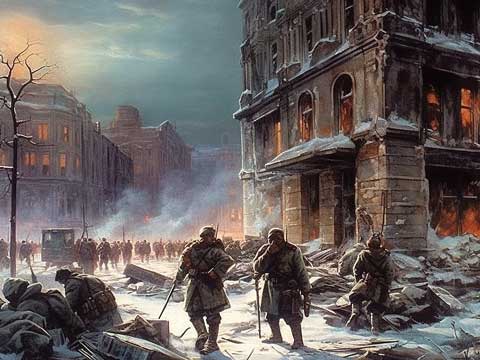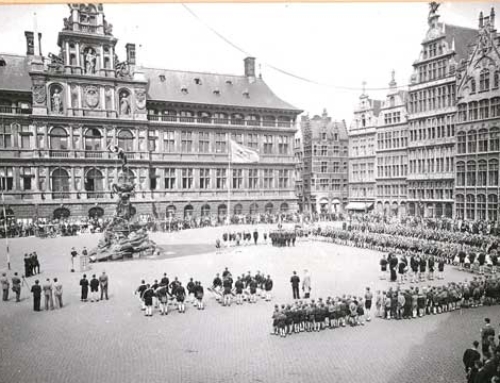If you missed our previous articles, we discussed the rise of the Third Reich, Hitler’s early years, the political strategies that brought him to power, and the Blitzkrieg that gripped Europe. But as with every story, there comes a moment when the tide turns: the battle for Stalingrad. And that’s precisely what we’ll be discussing today.
The Eastern Front: A Bloody Battle
The Eastern Front was a battlefield like no other. But before hell broke loose between Nazi Germany and the Soviet Union, these two superpowers had a surprising agreement: the Molotov-Ribbentrop Pact, also known as the German-Soviet Non-Aggression Pact. Signed in 1939, just a few days before the outbreak of World War II, both countries promised not to attack each other. This pact was beneficial for both parties. For Germany, it meant they could avoid a two-front war, as in World War I. For the Soviet Union, it provided time to build up their military forces and prepare for a possible future confrontation.
However, Hitler’s ambitions knew no bounds. In 1941, despite their earlier agreement, Nazi Germany launched Operation Barbarossa, a massive invasion of the Soviet Union. This treacherous act set the stage for a conflict that was both ruthless and devastating. The vast Russian plains became the scene of some of the most intense fighting of World War II. What followed was a battle of unprecedented scale and cruelty, in which both sides suffered massive losses.
Stalingrad: The Turning Point
The Battle of Stalingrad was not just a battle; it was an epic confrontation where the fate of the world seemed to hang in the balance. Imagine a city, once bustling with life, now transformed into an apocalyptic battlefield. The streets, once filled with the laughter of children and the hustle and bustle of daily life, were now overwhelmed by the sound of gunfire, explosions, and the desperate cries of soldiers.
Winter came early that year, and soldiers on both sides felt the bitter cold to the bone. German troops, accustomed to rapid Blitzkrieg victories, now found themselves pinned down in exhausting urban warfare. Every street, every building, even every room was fiercely contested. The Russian defenders, determined not to let their city fall, fought with a determination and courage that often surprised the Germans. For the Soviets, Stalingrad was more than just a strategic objective; it was a symbol of their national resolve and the will to survive.
The fighting in Stalingrad was so intense that soldiers often engaged in hand-to-hand combat, fighting for every inch of ground. Food and ammunition became scarce, and many had to survive on sheer willpower. Stories tell of soldiers seeing their fallen comrades as inspiration to carry on, determined not to let their sacrifices be in vain.
But amid this hell on earth, there were also moments of humanity. There were stories of enemies helping each other in the bitter cold or burying the dead together during a temporary ceasefire. These moments revealed the true nature of humanity, even in the darkest of times.
The Battle of Stalingrad was not only a turning point in the war but also a testament to the human spirit and the lengths people will go to defend their home.
Challenges on Multiple Fronts
While the snowstorms and relentless gunfire of the Eastern Front gripped the Nazis, a storm was brewing on the other side of Europe. The coasts of Normandy, with their sandy beaches and peaceful villages, were about to become the scene of one of the most ambitious military operations in history.
In the early hours of June 6, 1944, while most of the continent’s inhabitants were still in deep sleep, the engines of thousands of Allied ships cut through the Channel’s waves. Paratroopers silently descended from the sky, their silhouettes barely visible in the moonlight. The invasion of Normandy, better known as D-Day, had begun. The beaches of Omaha, Utah, Gold, Juno, and Sword would soon become synonymous with heroism and sacrifice.
At the same time, high above the German cities, the engines of Allied bombers roared. The air war over Germany was in full swing. Night after night, explosions lit up the sky as the Allies tried to break the morale and industrial capacity of the Third Reich.
It was a time of contrasts. While the Nazis still held vast swathes of Europe, the first signs of their impending downfall began to show. Cities that were once symbols of Nazi grandeur now lay in ruins. The once-proud Wehrmacht, which had marched across Europe with seemingly unstoppable force, now found itself in a defensive battle on multiple fronts.
The Third Reich, which had once dreamed of a thousand-year empire, was now on shaky ground. The Allies, united in their determination to free Europe, pressed on, determined to end the darkest period in modern history.
The Past as Mirror and Compass
In the shadow of the devastation and tragedies of World War II, it’s sometimes tempting to view these events as distant echoes, disconnected from our current times. But the reality is that the echoes of the past often resonate in our present moments, warning of the dangers of forgetfulness.
The challenges, conflicts, and decisions of the past are not just historical footnotes; they are vivid reminders of what can happen when hatred, intolerance, and power lust go unchecked. “Those who forget the past are doomed to repeat it.” These words are not just a warning but also a call to vigilance. In an era where geopolitical tensions are once again coming to the fore, where old wounds are being reopened and new conflicts loom, it’s crucial that we take the lessons of the past to heart.
Our journey through the history of the Third Reich is not just a dive into the past but also a mirror for the future. By understanding where we come from, we can better navigate where we’re going.
So, stay with us. In our upcoming articles, we’ll delve deeper, exploring the depths of history and examining the reflections that still shape us today. See you soon!






